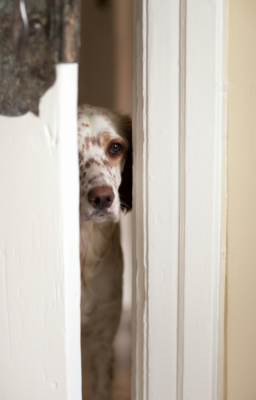Is your Velcro dog at risk for separation anxiety? It sure would seem logical to think that, wouldn’t it? It would make complete sense to assume that if you can’t walk from one room to another without your dog following you, that she must completely fall apart when you’re gone and she’s left alone. Similarly, you could read into thinking your dog is upset that you’re leaving if she gets a little antsy when you’re putting your shoes on or when you pick up your keys. Or what about if she’s really excited when you return? Are any of these actual indicators of separation anxiety?
In a study from 2001 that looked ar risk factors associated with separation anxiety, it was found that high percentages of dogs without separation anxiety do these “Velcro” dog behaviors like shadowing, but don’t have separation anxiety. My own dog, BooBoo, is the most Velcro dog I have ever met but happy snoozes when I leave the house. My husband marvels “how does she not have separation anxiety?” and it’s because shadowing or over-attachment wasn’t found to be a reliable diagnostic criteria for separation anxiety. In the study, 64% of dogs had “moderate to severe” following of owner but didn’t have separation anxiety. Those same non-SA dogs also had percentages of increased greeting behaviors, and signs of angst at owner putting shoes on or sound of keys. But they didn’t have separation anxiety.
I will often have clients concerned that their dog is a Velcro dog, as if your dog wanting to be close to you and hang out and taking peace and comfort being near you is a bad thing. I remind them that dogs are social creatures – they want to be near us, which is why dogs who get relegated to living outside often are so unhappy and can develop behavioral issues.
When we talk about separation anxiety and look to figure out if a dog actually has separation anxiety, let’s be sure to focus on the real indicators that matter, not the red herrings, like your dog wanting to spy on you when you potty. (Maybe it’s just payback – you watch her when she potties, *joking*). So what should we be focusing on? Let’s take note of more reliable indicators of separation anxiety – vocalization, housebreaking accidents when alone (when otherwise housebroken) and destruction (including exit-points) and physical changes in the dog like refusal to eat, drooling, panting, vomiting and self-injury. These symptoms are much more reliable indicators of separation anxiety, And when we’ve confirmed that’s the issue, then we can work on helping the dog learn to be more comfortable with absences using a systematic desensitization process. We don’t focus on getting the dog to stop barking – we need to focus on helping her feel comfortable being left alone and when we do that, the barking goes away on its own.
And please, do not take any advice that encourages you to across the board ignore your dog for being prosocial. I doubt you got a dog to ignore her. Absolutely obedience and manners are important and I’m not saying pay attention to a dog who is demand barking for dinner but a down-stay on a mat will not cure your dog’s separation anxiety and neither will ignoring her if she wants to snuggle with you.
For more help on what NOT to do if your dog has separation anxiety, download my free 17-page guide: 5 Suggestions That Won’t Help Your Dog’s Separation Anxiety (and might make it worse).
If you and your dog are struggling with separation anxiety, I can help. Set up your assessment today. Or pick up my self-paced Separation Anxiety Foundations course.
Happy training!
![]()




